In the modern era, where digital transformation is not just an option but a necessity, the role of high-speed internet in businesses has become more critical than ever. The advent of fibre optic networks has revolutionised how businesses operate, communicate, and grow. Here’s a closer look at the indispensability of high-speed communication in today’s business landscape.
High-Speed Internet: The Backbone of Modern Business Operations
Seamless Communication and Collaboration: With fibre optic networks, businesses enjoy seamless communication and collaboration, enabling teams to work together efficiently, irrespective of geographical location.
E-commerce and Online Transactions: For e-commerce-dependent enterprises, high-speed internet ensures quick webpage loading, smooth online payment processing, and efficient order fulfilment.
Data-Intensive Tasks: Businesses engaged in data information greatly benefit from high-speed internet’s swift data processing capabilities.
Benefits of High-Speed Internet for Businesses
Enhanced Productivity and Workflow Efficiency: The reliability and speed of fibre optic networks lead to improved employee productivity and streamlined workflows.
Cost Efficiency: Despite the initial setup costs, the long-term savings associated with reduced downtime and faster operations make high-speed internet a cost-effective choice for businesses.
Competitive Advantage: Access to real-time collaboration tools, enhanced customer service, and efficient data backups give businesses a significant edge over competitors.
The transition to fibre optic networks is not just a technological upgrade; it’s a strategic move towards future-proofing businesses. The unparalleled data transmission speeds, low latency, and scalability offered by fibre optics are indispensable in an age where the demand for bandwidth and quality of internet service is ever-increasing. As we witness a global push towards enhancing digital infrastructure, the fibre optic network emerges as the only viable option for businesses aiming for high-speed, reliable, and affordable communication solutions.
Fibre Optic, Voice, and Data Design: Unpacking the Backbone of Digital Transformation
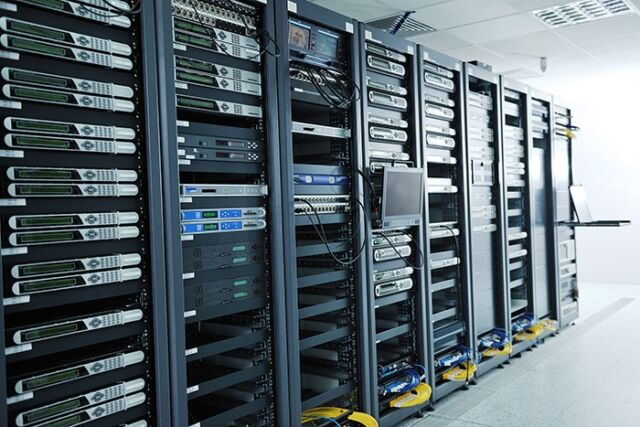
In the realm of digital transformation, the design and implementation of fibre optic, voice, and data systems form the cornerstone of modern communication infrastructure. This section delves into the essential components and services that cater to the diverse needs of businesses, facilitating their journey towards embracing cutting-edge technology.
Internet Services Designed for Business Needs
Access to the NBN network, including Enterprise Ethernet, offers high-capacity fibre optic connections, crucial for businesses requiring robust internet services. These services ensure reliable access points for seamless operations. Cloud and connectivity services such as Hosted PABX Systems, SIP Trunks, Cloud and IP Transit, and Office 365, leverage the power of optical fibre cables to provide secure and efficient communication channels, essential for modern business ecosystems. Business Wireless solutions complement fibre optics by providing flexible and scalable access points, ensuring businesses remain connected even in the absence of physical cabling.
Fibre Optic Cabling Installation and Benefits
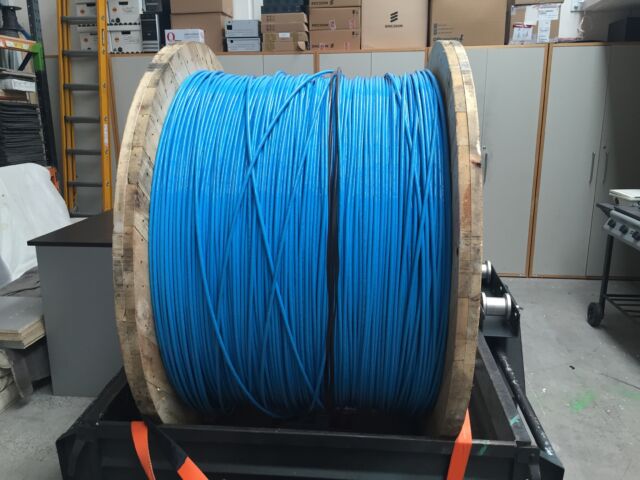
Fixtel installation services cover single-mode, multimode, and optical fibre systems, each catering to different data transmission needs and environments. Professional services include thorough site surveys, project management, splicing, and termination of cables, ensuring the fibre optic network is optimised for speed and reliability.
Fibre-optic connections offer significantly faster speeds and higher bandwidth, enabling more information transmission per unit time. This is crucial for businesses leveraging cloud-based services and VoIP capabilities.
Upgrading IT Infrastructure to fibre optic prepares businesses for digital transformation, allowing them to harness advanced technologies such as AI and ML. This transition is supported by comprehensive design, installation, and ongoing maintenance services from Fixtel. Our team can walk you through the steps and prepare a cost installation quote for your specific business needs.
Fixtel’s approach to fibre optic, voice, and data design involves creating customised solutions based on unique business requirements, ensuring efficient installation and providing ongoing support and maintenance.
Embracing Cutting-Edge Infrastructure – What It Means for Your Business
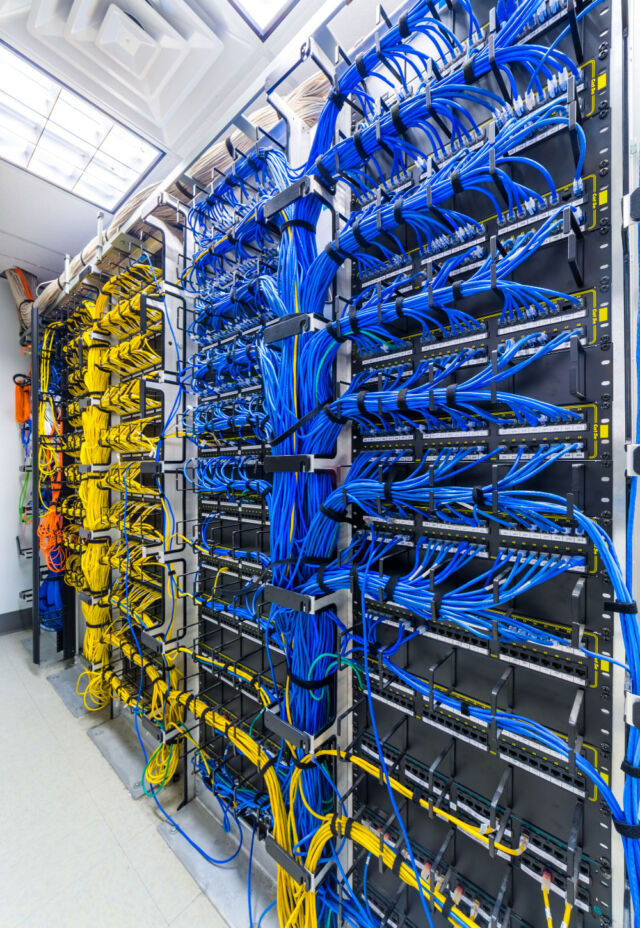
Embracing cutting-edge infrastructure, particularly a fibre optic network, is a transformative step for businesses aiming to stay competitive and future-proof their operations. The integration of cloud and data services is not just an upgrade; it’s a strategic move towards enhancing productivity, ensuring compatibility with cloud-based services, and leveraging technologies like AI and machine learning. Here’s what adopting this infrastructure means for your business:
Future-Proofing and Scalability:
- High Bandwidth and Low Signal Loss: Fibre optic networks offer superior bandwidth and minimal signal loss, which is crucial as businesses grow and their data transmission needs increase.
- Scalability: These networks can be easily expanded or upgraded, allowing businesses to adjust their bandwidth requirements without significant infrastructure changes, ensuring they are always ahead of technological demands.
- Cost-Effective Solutions: Long-term cost savings, lower power usage, and the durability of fibre optics reduce the overall operational costs, making it a wise investment for the future.
Security and Reliability:
- Advanced Security Solutions: Implementing fibre optic networks significantly improves the security of IT environments. The use of advanced encryption technologies and a fortified infrastructure protects against evolving cyber threats, safeguarding sensitive digital assets.
- Reliable Connections: Robust and scalable network infrastructures ensure reliable connections even during peak usage times, minimising the risk of disruptions caused by network outages or slow connectivity.
Optimising Business Operations:
- Streamlining Processes: Optimising IT environments with fibre optics automates and streamlines business processes, improving system performance and reducing downtime.
- Remote Work Enablement: High-quality hardware and software minimise the risk of distractions and errors, enabling remote work and easy collaboration from any location.
- Strategic IT Planning: Fixtel offers comprehensive planning, installation, and ongoing management services, helping businesses identify and implement the right IT infrastructure to optimise operations and promote growth.
By transitioning to a fibre optic network, businesses not only enhance their current operations but also lay a solid foundation for embracing future technological advancements. This strategic upgrade positions companies to efficiently handle increasing data loads, secure their operations against cyber threats, and adapt to the evolving digital landscape, all while achieving cost efficiency and operational excellence.
Beyond the Copper Legacy: The Transition to Future-Proof Infrastructure

Transitioning from copper to fibre optic networks represents a monumental shift in the infrastructure underlying modern communication systems. This move is not just about keeping pace with technological advancements but about setting a new standard for speed, reliability, and overall performance. Below are key points illustrating the comparative advantages of fibre optics over traditional copper networks:
Performance and Reliability:
- Long-Distance Signal Transmission: Fibre optic cables can transmit signals over much longer distances with less signal degradation compared to copper cables. This attribute is crucial for maintaining high-quality communication across vast networks.
- Resistance to Electromagnetic Interference: Unlike copper cables, fibre optics exhibit greater resistance to electromagnetic noises, which reduces interference and enhances the integrity of data transmission.
- Durability and Lifespan: Optical fibre is not only thinner and lighter than copper but also more resistant to damage and environmental conditions, boasting a longer life cycle of over 100 years.
Security and Future-Proofing:
- Enhanced Security Measures: Fibre optic cables are more secure than copper networks, as they are nearly impossible to tap into without detection. This provides a more secure medium for data transmission, crucial for sensitive information.
- Scalability and Flexibility: The inherent properties of fibre optics, such as higher frequency rates and greater bandwidth, offer unmatched scalability. This ensures that as a business’s needs grow, its network can adapt without the need for a complete overhaul.
The Shift from Traditional Copper Networks to High-Capacity Fibre Optics
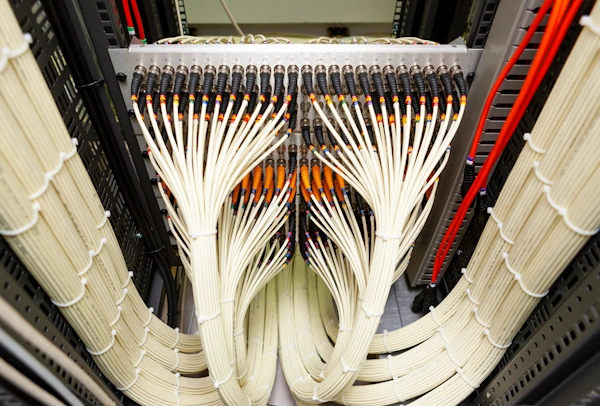
Transitioning from traditional copper networks to high-capacity fibre optics marks a significant evolution in the realm of telecommunications and internet infrastructure. The differences between these two technologies are stark, affecting everything from bandwidth capabilities to overall reliability and security. Here’s a comparative look at the key aspects of copper versus fibre optic networks.
Performance and Capacity
Bandwidth:
- Copper: Up to 10 GB per second
- Fibre: Up to 60 TB per second
Speed:
- Copper: Maximum speeds of 10 GB per second
- Fibre: Can achieve speeds up to 60 TB per second
Reach/Distance Supported:
- Copper: Effective up to approximately 100 metres
- Fibre: Some types can carry signals up to 25 miles
Reliability and Durability
Signal Loss:
- Copper: Experiences up to 94% signal loss over distances greater than 100 metres
- Fibre: Only 3% signal loss over similar distances
Interference and Durability:
- Copper: Vulnerable to electromagnetic interference, lightning, and radio signals
- Fibre: Resistant to these factors and boasts a longer lifespan due to its durability
Security:
- Copper: Can be easily tapped, posing a security risk
- Fibre: Offers enhanced security as it doesn’t carry electronic signals and is almost impossible to tap
Speed and Reliability: Why They Matter for Modern Businesses
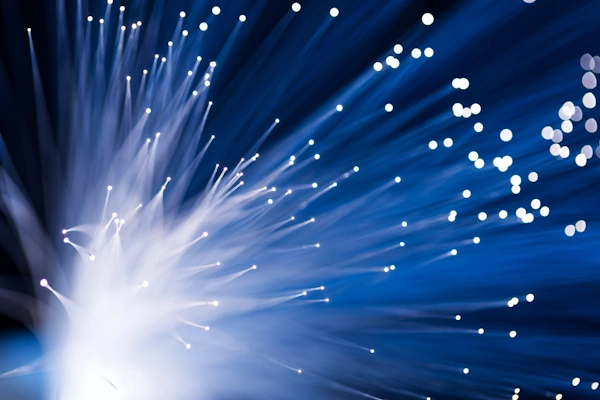
In the digital age where every second counts, the speed and reliability of an internet connection can significantly impact a business’s operations and its relationship with customers. High-speed internet, especially fibre optic networks, has become a critical asset for businesses aiming for efficiency and growth. Here are the key reasons why:
Real-time Collaboration: With speeds of 1 Gbps or higher, fibre internet enables teams across the globe to collaborate in real-time through video calls and cloud computing, ensuring productivity doesn’t skip a beat.
Efficient Data Access: Instant access to data and applications speeds up decision-making and project completion, directly contributing to a business’s bottom line.
Enhanced Customer Experience: High-speed internet improves customer service by facilitating prompt online support and enabling high-definition video and music streaming services with minimal buffering.
Consistent Uptime: Fibre Internet’s dedicated infrastructure is less prone to weather disruptions, ensuring businesses stay online no matter what.
Lower Maintenance: The minimal signal degradation over time with fibre means fewer maintenance calls, translating into cost savings and less downtime.
Multiple User Support: Unlike traditional broadband, high-speed fibre internet supports multiple users and devices without performance lags, ensuring smooth operations.
Cloud-Based Solutions: Easy access to cloud storage for backup and data restoration ensures business continuity without impacting operational tasks.
Virtual and Augmented Reality: For industries leveraging VR and AR, high-speed internet delivers the rapid data transmission required for realistic and engaging user experiences.
In summary, the shift to fibre optic networks is not just about faster internet speeds but about building a reliable, secure, and scalable IT infrastructure. This enables businesses to deliver quality services efficiently, improve customer satisfaction, and stay competitive in the fast-paced digital marketplace.
Unmatched Speeds: Facilitating Seamless Operations and Communications
Fibre optic networks are revolutionising the way businesses and individuals connect and communicate, primarily due to their ability to significantly reduce latency issues. This improvement in latency is not just a number; it translates into tangible benefits across various applications:
Voice Over Internet Protocol (VoIP) Users:
Before: Traditional networks often suffer from lag and jitter, causing poor voice quality and dropped calls.
After: Fibre optics offer a smoother experience with clearer voice quality, making VoIP a reliable alternative to traditional phone lines.
Cloud Application Performance:
Before: Accessing cloud-based applications can sometimes feel sluggish, with delayed responses affecting productivity.
After: With fibre optics, businesses and users experience enhanced performance, as data retrieval and storage operations become almost instantaneous.
Video Streaming:
Before: Video buffering and resolution downgrading are common issues, detracting from the viewing experience.
After: Fibre optic networks enable smoother video streaming at higher resolutions without interruptions, ideal for both leisure and professional webinars or conferences.
The shift to fibre optics is akin to moving from a congested highway to a high-speed expressway, where information flows rapidly and efficiently. This leap in technology is not just about speed; it’s about creating a seamless operational and communication environment that supports current needs and is ready for future advancements.
Enhanced Security: Safeguarding Your Data in the Digital Age
In the digital age, safeguarding sensitive data is not just a priority; it’s a necessity. With businesses and individuals increasingly reliant on digital platforms, the security of data transmission has become paramount. Fibre optic networks, known for their high speed and reliability, also offer superior security features compared to traditional copper networks.
Key Security Measures for Fiber Optic Networks:
- Firewalls and Encryption: Essential for protecting data from unauthorised access, firewalls act as a barrier, while encryption scrambles data into an unreadable format for anyone without the key.
- Intrusion Detection Systems (IDS): These systems monitor network traffic for suspicious activity and potential threats, providing an additional layer of security.
- VPN Services: Virtual Private Networks (VPNs) create a secure connection over the internet, masking the user’s IP address and encrypting data transfer, making it difficult for cybercriminals to intercept.
- Managed Security Services: Offering a comprehensive approach, these services include regular audits, real-time monitoring, and immediate response to threats, ensuring round-the-clock protection.
Understanding and Mitigating Fibre Optic Tapping:
- Optical Time-Domain Reflectometry (OTDR): This method involves sending a series of light pulses down the fibre optic cable to detect any instances of tapping.
- Optical Power Monitoring: By continuously monitoring the power levels of light within the cable, any unexpected drops can signal a potential tap.
- Physical Inspections: Regular inspections of the physical infrastructure can identify any unauthorised access points.
Inherent Security Advantages of Fiber Optics:
- No Electromagnetic Leakage: Unlike copper cables, fibre optic cables do not emit electromagnetic signals, making it nearly impossible for data to be intercepted through ambient signal infiltration.
- Difficult to Tap: The physical characteristics of fibre cables make them more difficult to breach without detection. If a tap is attempted, the network administrator receives immediate alerts, enabling a swift response to the threat.
By integrating these robust security measures and taking advantage of the inherent security benefits of fibre optics, businesses and individuals can significantly enhance the protection of their sensitive data. This comprehensive approach to security not only prevents data breaches and cyber-attacks but also builds trust with customers and partners in an increasingly interconnected world.
Consultation and Customised Planning: Tailoring Solutions to Your Business Needs

Embarking on upgrading to a fibre optic network involves meticulous planning and strategic execution. The initial step, consultation, and customised planning, is pivotal in tailoring solutions that align with a business’s unique needs. This phase encompasses several key components:
Defining Project Objectives and Specifications:
- Understanding customer needs
- Establishing project goals and technical requirements
Strategic Planning Elements:
- Comprehensive Project Plan: Outlines tasks, milestones, and deliverables.
- Quality Assurance: Incorporates testing protocols to ensure network reliability.
- Troubleshooting Framework: Prepares for potential issues, enabling quick resolution.
Technical and Regulatory Considerations:
- Design Software Utilisation: Employing fibre network design software for precise planning.
- Compliance: Adhering to industry standards and regulations.
- Network Layout and Components: Determining the network’s configuration and essential components.
Operational Efficiency:
- CapEx Reduction: Strategies to decrease capital expenditure in optical network design.
- Standardised Procedures: Establishing guidelines applicable to all stakeholders.
By focusing on these foundational aspects, businesses can ensure their fibre optic network is designed and implemented to meet current needs while remaining adaptable for future expansions. This careful planning not only saves time and resources during installation but also facilitates day-to-day network management and paves the way for seamless scalability.
Professional Installation with Minimal Disruption
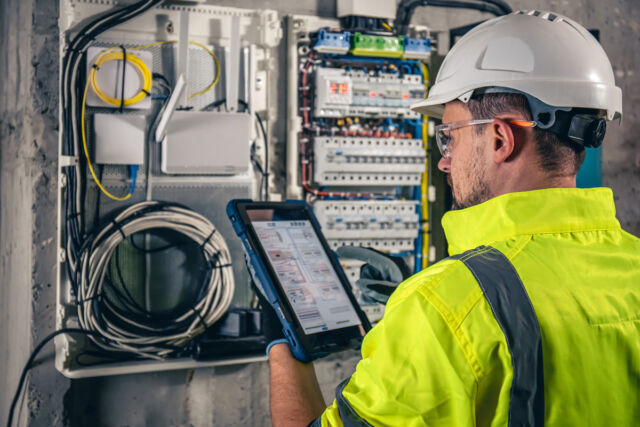
When it comes to the professional installation of fibre optic networks, minimal disruption and ensuring business continuity are paramount. The process is meticulously designed to allow businesses to resume operations swiftly, supported by exceptional assistance throughout the project lifecycle. Here are the critical steps and considerations to ensure a smooth installation:
Conclusion: Leading Your Business into the Future with Fixtel
The transformative power of fibre optic networks and their pivotal role in modern business operations means enhancing productivity for businesses of all industries. Fibre optics serve as the backbone of digital transformation. From competitiveness to data security and future-proofing infrastructure against emerging technological demands The unparalleled advantages over traditional copper networks – including superior speed, reliability, environmental friendliness, and cost efficiency – underscore the significance of transitioning to high-capacity fibre optics for businesses aiming to thrive in the digital arena.
As we move forward, the importance of adopting fibre optic technology cannot be overstated, especially for organisations seeking to optimise operations, secure their data, and prepare for the demands of tomorrow’s digital landscape. With the guidance of Fixtel, businesses can navigate the complexities of upgrading their communication infrastructure, ensuring minimal disruption and maximum benefit. Embracing fibre optic networks not only signifies a step towards advanced connectivity and operational excellence but also aligns with the strategic vision of future-proofing one’s business in the ever-evolving digital age.
